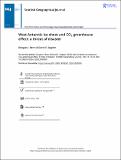Files in this item
West Antarctic Ice Sheet and CO2 greenhouse effect : a threat of disaster
Item metadata
| dc.contributor.author | Benn, Doug I | |
| dc.contributor.author | Sugden, David E. | |
| dc.date.accessioned | 2021-03-23T14:30:02Z | |
| dc.date.available | 2021-03-23T14:30:02Z | |
| dc.date.issued | 2021-02-14 | |
| dc.identifier | 271330739 | |
| dc.identifier | 74c5443d-bc1e-4adb-8270-61c639e8ff37 | |
| dc.identifier | 85100926032 | |
| dc.identifier | 000617980600003 | |
| dc.identifier.citation | Benn , D I & Sugden , D E 2021 , ' West Antarctic Ice Sheet and CO 2 greenhouse effect : a threat of disaster ' , Scottish Geographical Journal , vol. 136 , no. 1-4 , pp. 13-23 . https://doi.org/10.1080/14702541.2020.1853870 | en |
| dc.identifier.issn | 1470-2541 | |
| dc.identifier.other | ORCID: /0000-0002-3604-0886/work/91340766 | |
| dc.identifier.uri | https://hdl.handle.net/10023/21690 | |
| dc.description | DIB's contribution to this work is from the DOMINOS project, a component of the International Thwaites Glacier Collaboration (ITGC). Support for DIB was provided by the Natural Environment Research Council (NERC: Grant NE/S006605/1). ITGC Contribution No. ITGC:025. | en |
| dc.description.abstract | Over 40 years ago, the glaciologist John Mercer warned that parts of the West Antarctic Ice Sheet were at risk of collapse due to the CO2 greenhouse effect. Mercer recognised the unique vulnerability of ice sheets resting on beds far below sea level (marine-based ice sheets), where an initial warming signal can initiate irreversible retreat. In this paper, we review recent work on evidence for ice sheet collapse in warmer periods of the recent geological past, the current behaviour of the ice sheet, and computer models used to predict future ice-sheet response to global warming. Much of this work points in the same direction: warming climates can indeed trigger collapse of marine-based portions of the West Antarctic Ice Sheet, and retreat in response to recent warming has brought parts of the ice sheet to the threshold of instability. Further retreat appears to be inevitable, but the rate of collapse depends critically on future emissions. | |
| dc.format.extent | 1544131 | |
| dc.language.iso | eng | |
| dc.relation.ispartof | Scottish Geographical Journal | en |
| dc.subject | Ice sheet instability | en |
| dc.subject | Antarctica | en |
| dc.subject | Climate change | en |
| dc.subject | G Geography (General) | en |
| dc.subject | T-NDAS | en |
| dc.subject | SDG 13 - Climate Action | en |
| dc.subject | SDG 14 - Life Below Water | en |
| dc.subject.lcc | G1 | en |
| dc.title | West Antarctic Ice Sheet and CO2 greenhouse effect : a threat of disaster | en |
| dc.type | Journal article | en |
| dc.contributor.sponsor | NERC | en |
| dc.contributor.institution | University of St Andrews. Environmental Change Research Group | en |
| dc.contributor.institution | University of St Andrews. Bell-Edwards Geographic Data Institute | en |
| dc.contributor.institution | University of St Andrews. School of Geography & Sustainable Development | en |
| dc.identifier.doi | https://doi.org/10.1080/14702541.2020.1853870 | |
| dc.description.status | Peer reviewed | en |
| dc.identifier.grantnumber | NE/S006605/1 | en |
This item appears in the following Collection(s)
Items in the St Andrews Research Repository are protected by copyright, with all rights reserved, unless otherwise indicated.

